Take Me to the Recipes!
Embark on a tantalizing journey through the diverse and flavorful world of Uzbekistan food, where history, geography, and culture converge to create a culinary tapestry like no other.
Nestled at the crossroads of the ancient Silk Road, Uzbekistan boasts a rich heritage that has left an indelible mark on its food. From the iconic plov, considered the national dish, to a myriad of dumplings, stews, and vibrant salads, Uzbek cuisine reflects the country’s cultural mosaic.
This article delves into the heart of Uzbekistan’s gastronomy, exploring the influences of its history, the impact of climate and geography on ingredients, the essence of culinary traditions, and the health implications of its distinctive dishes.
Join us as we unravel the flavors that define the culinary identity of Uzbekistan, inviting you to savor the richness and uniqueness of this Central Asian culinary gem.
Uzbekistan Food – Key Takeaways
| Topic | Summary |
| Uzbekistan Food Diversity | Uzbekistan’s cuisine reflects a rich tapestry of flavors. Plov, the national dish, showcases aromatic rice, meat, and vegetables. Manti, dumplings filled with spiced meat, offer a delightful taste of Uzbek hospitality. |
| Uzbek Tea Culture | Tea holds a special place in Uzbek culture. It’s a symbol of hospitality, with green tea being a popular choice. The traditional tea ceremony, often accompanied by sweets, creates a warm and inviting atmosphere. |
| Exploring Uzbek Spices | Uzbek cuisine relies on a blend of spices, including cumin, coriander, and paprika. These spices add depth and flavor to dishes like shashlik, skewered and grilled meat. The spice markets offer a sensory delight for visitors. |
| Popular Street Food in Uzbekistan | Uzbek street food is a gastronomic adventure. Samsa, chak-chak, shawarma, and mastava are among the popular street foods. These treats, bursting with flavors, provide an authentic taste of Uzbekistan’s culinary scene. |
| Unique Uzbekistan Desserts | Uzbek sweets offer a symphony of sweetness. Navat, halva, sumalak, and peshmak are notable desserts. From crystallized sugar strands to nutty halva, Uzbekistan’s dessert selection adds a delightful conclusion to any meal. |
You may also Enjoy the Following Articles
- North and South American Cuisine – A Culinary Expedition
- European Cuisine: Savor the Continent’s Best Culinary Secrets!
- African Cuisine: Discover the Bold Flavors & Global Charm!
- Asian Cuisine Unlock its Secrets – Taste, Health & Global Influence!
- Oceania Cooking: A Culinary Journey Through the Pacific
Take Me to the Uzbekistan Food Recipes!
Where is Uzbekistan?


Index to the Contents
- Uzbekistan’s History and Its Influence on Cuisine
- How Uzbekistan’s Climate and Geography Influence Cuisine
- Understanding the Essence of Uzbek Cuisine
- Tea Culture in Uzbekistan
- Uzbek Culinary Traditions
- The Role of Bread in Uzbek
- Health Implications of Uzbekistan Cuisine
- Vegan and Vegetarian Options in Uzbek Cuisine
- Uzbek National Dish
- Variations of Uzbek Cuisine Across Regions
- Exploring Uzbek Ingredients: The Flavors of Uzbekistan Cuisine
We invite you to savor iconic Uzbekistan Food recipes – Click on each tantalizing picture to open up the menu
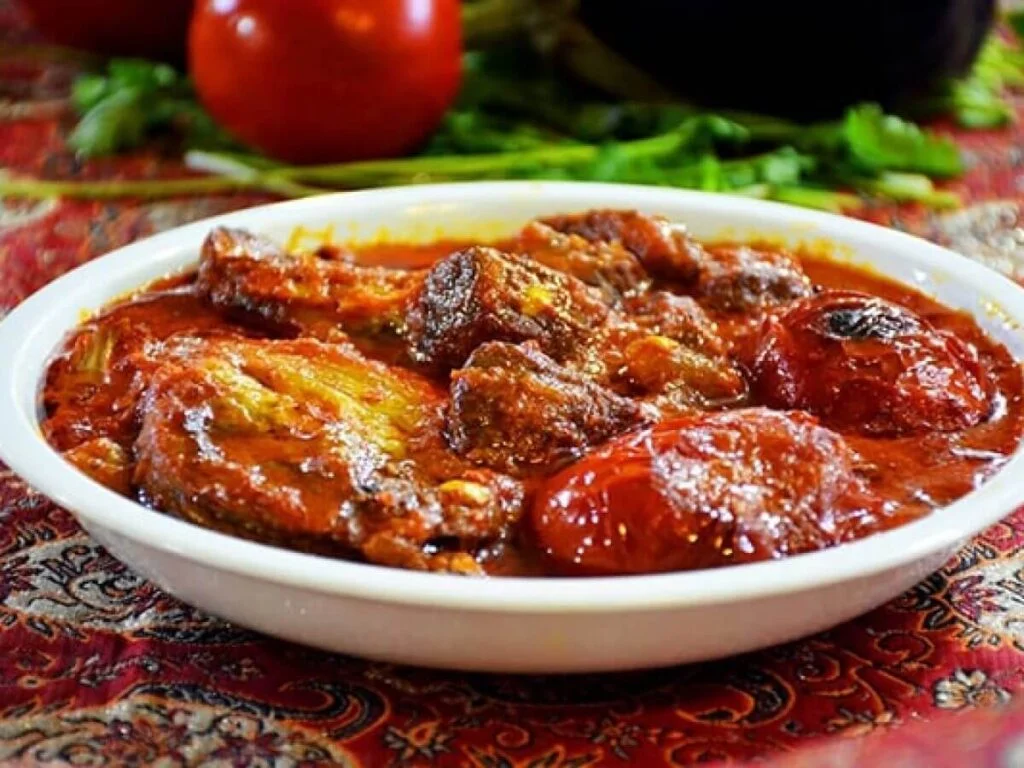


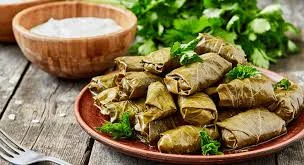

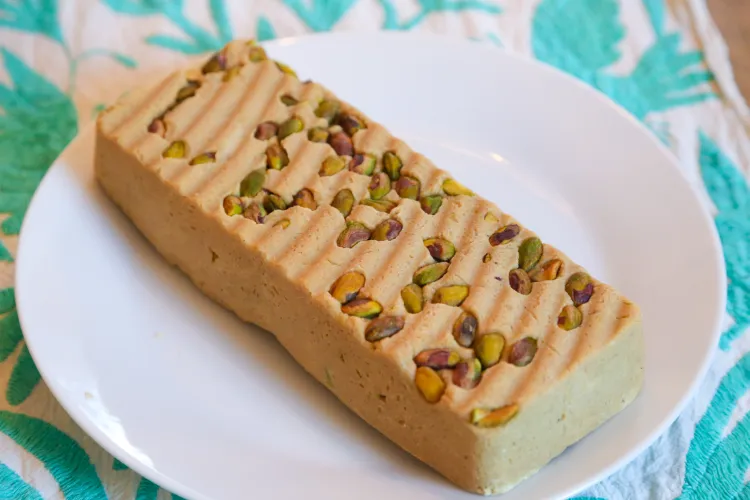
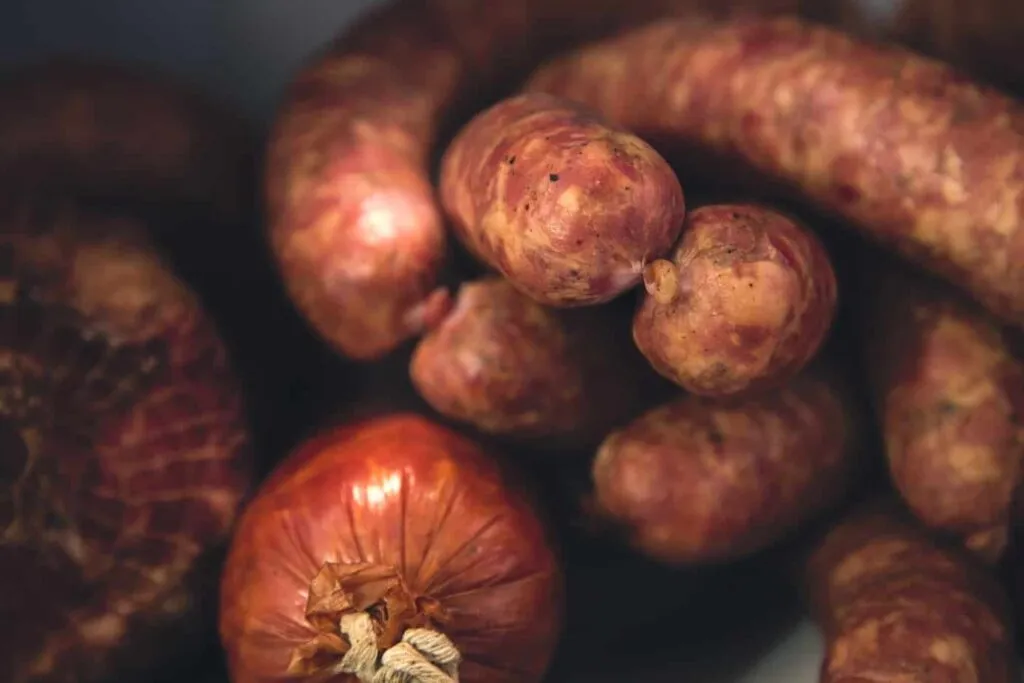
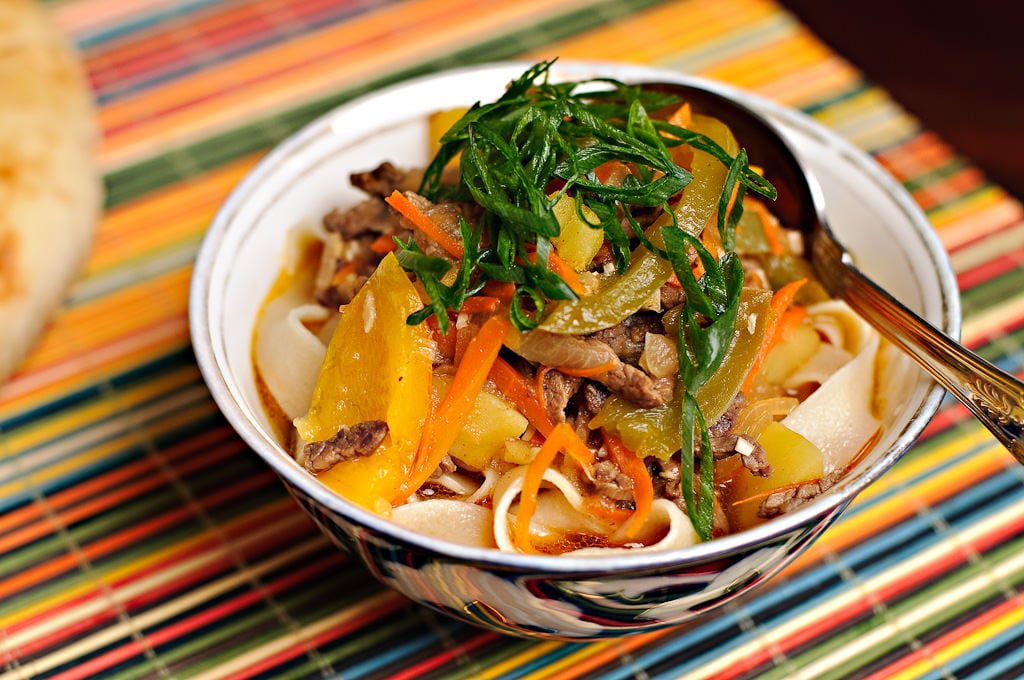
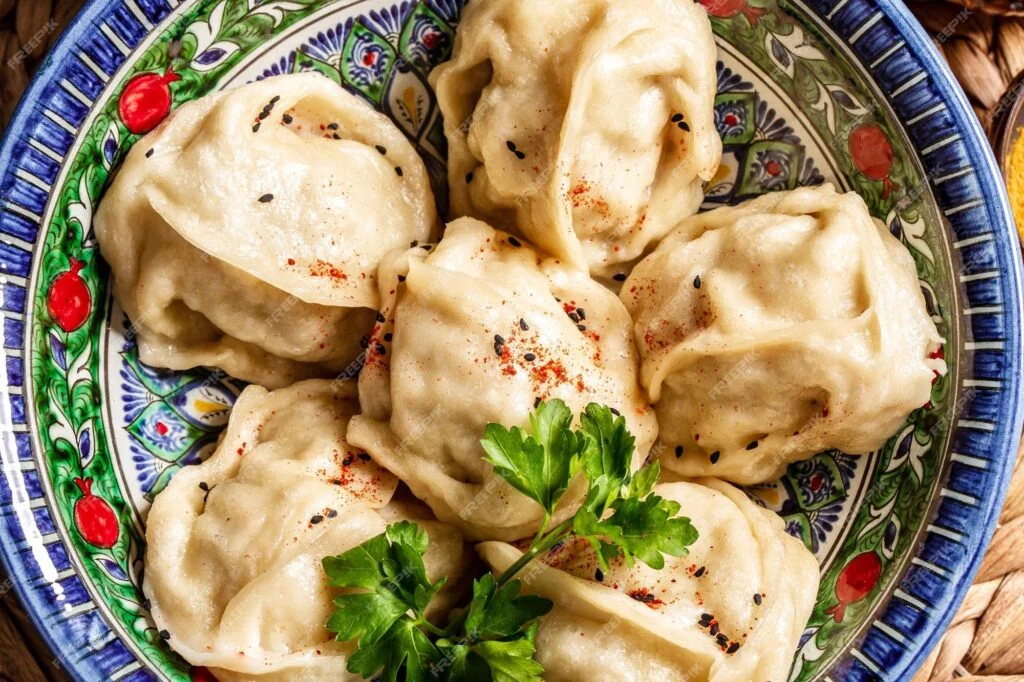
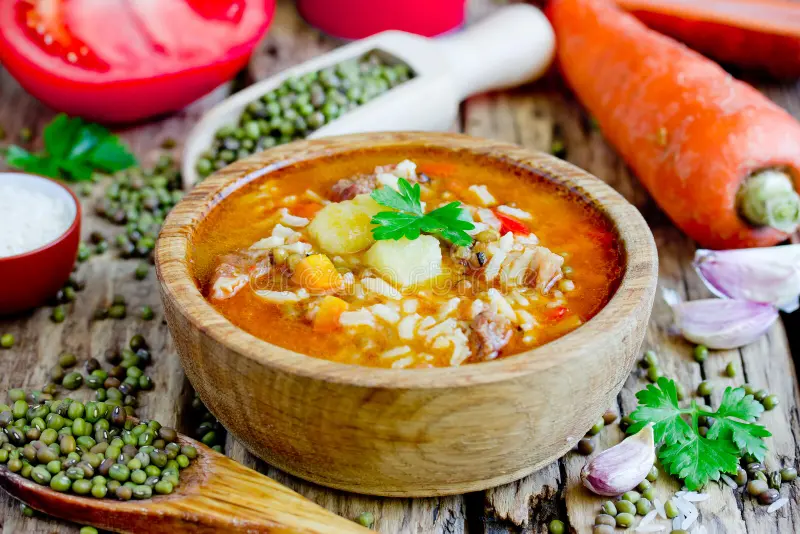
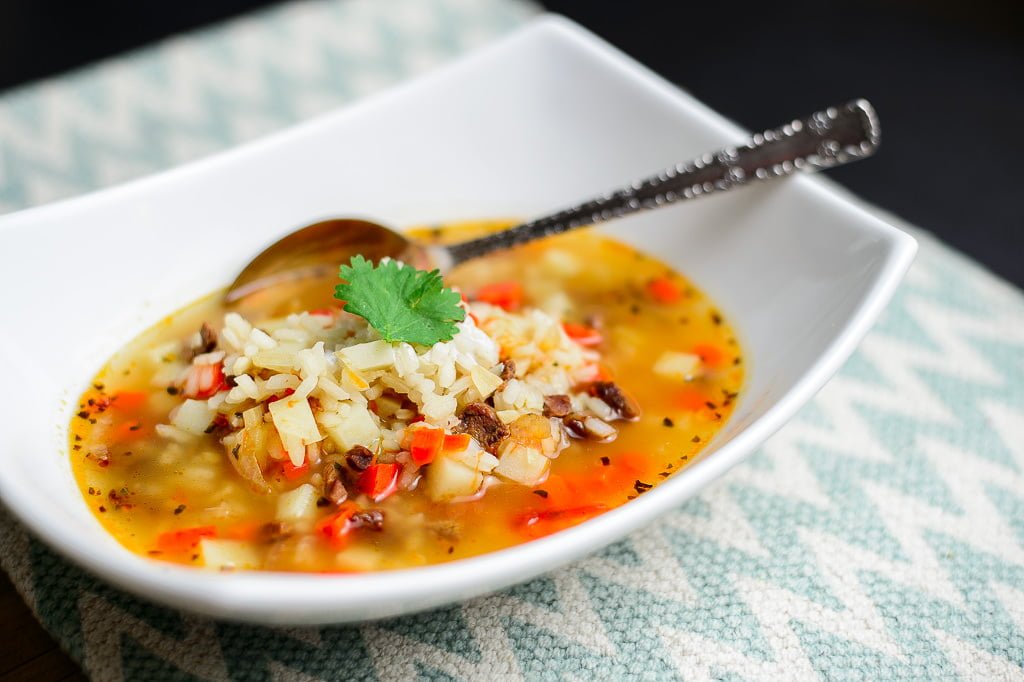
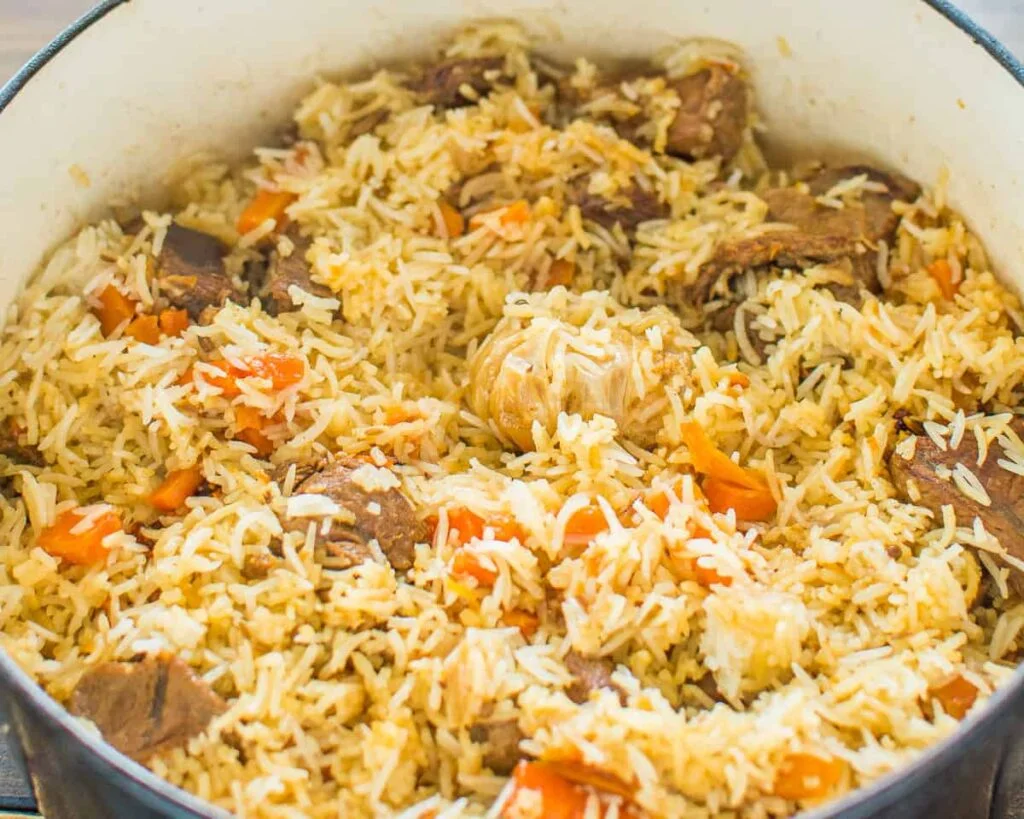

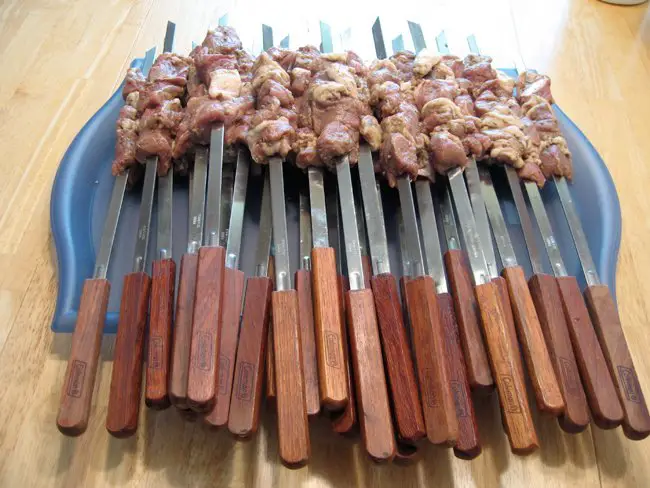


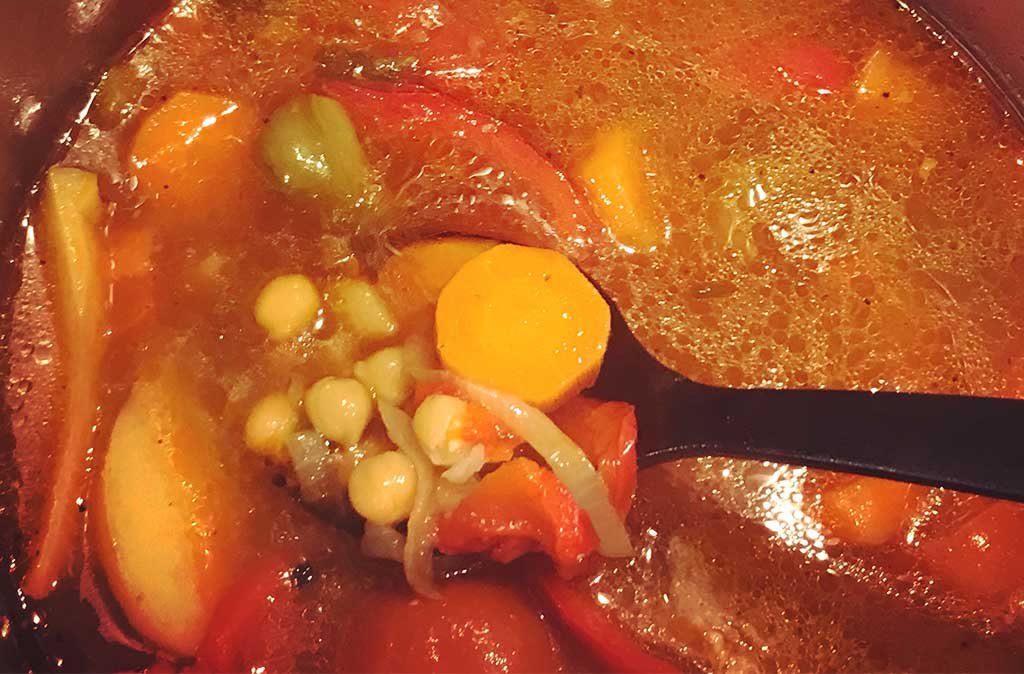
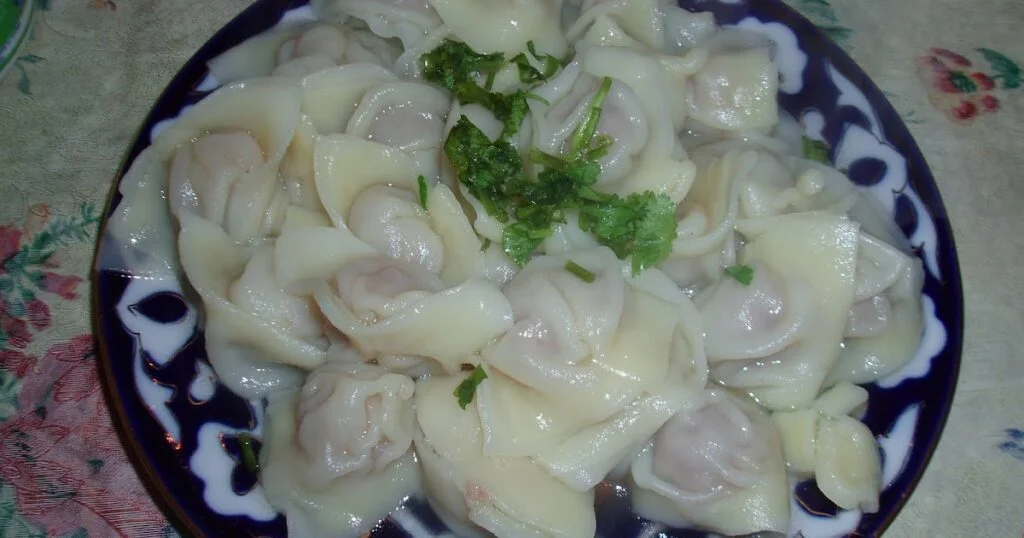
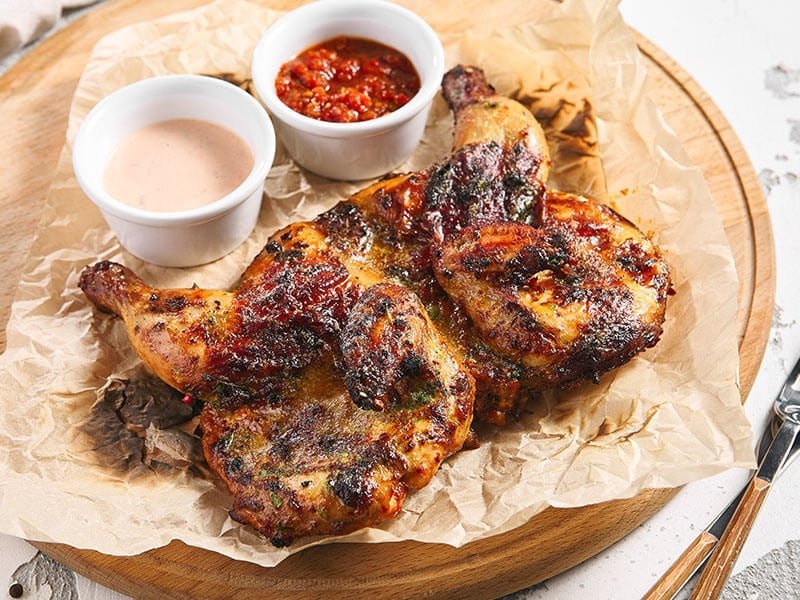
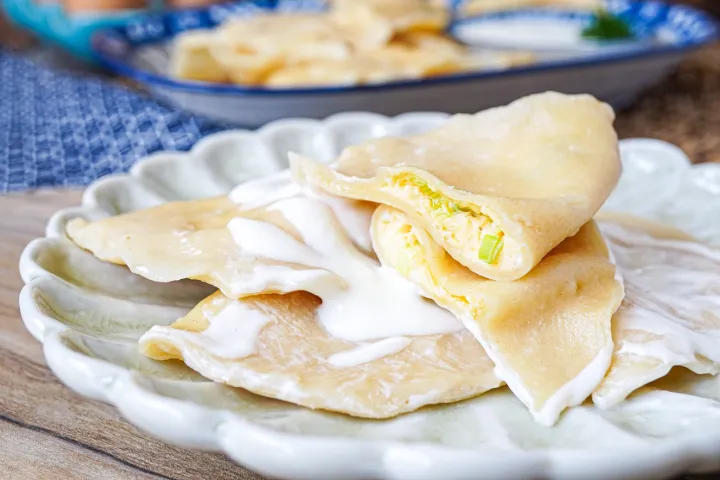
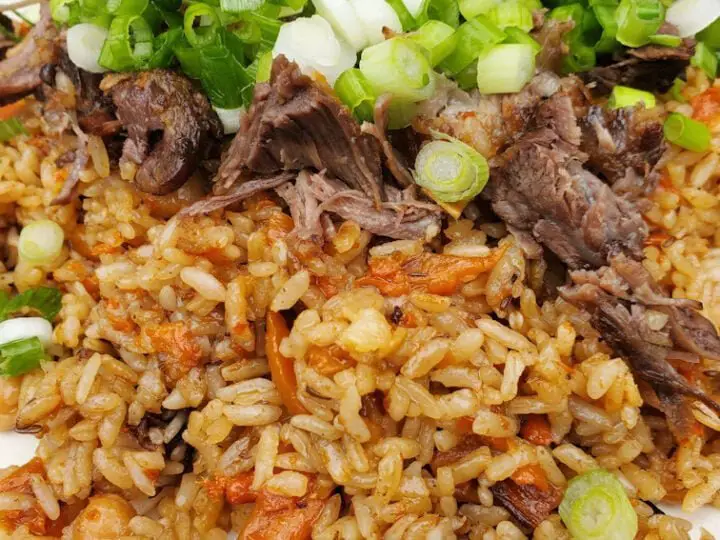

Uzbekistan Food – Recipes to try at home
Uzbek cooking technique are easy to try out in your home. Here are some of the most popular recipes for you to try out.
Uzbekistan Food – Plov: A Culinary Journey through Flavorful Traditions

History and Background of Uzbek Plov
Uzbek Plov, considered the national dish of Uzbekistan, boasts a rich history dating back centuries. Influenced by the Silk Road trade routes, this aromatic rice pilaf reflects the cultural amalgamation that defines Uzbek cuisine.
Traditionally cooked in massive cauldrons over an open fire, Plov has become a symbol of communal feasting and celebration, embodying the essence of Uzbek hospitality.
Uzbekistan Food – Plov: Ingredients
- Basmati or long-grain rice
- Lamb or beef, cubed
- Onions, finely sliced
- Carrots, julienned
- Garlic, minced
- Raisins
- Apricots, dried and chopped
- Vegetable oil or lamb fat
- Cumin, coriander, and black pepper (ground)
- Bay leaves and cumin seeds for fragrance
- Salt to taste
Uzbekistan Food – Plov: Recipe
- Rinse the rice thoroughly and soak it for 30 minutes.
- Heat oil or lamb fat in a large, heavy-bottomed pan. Sauté sliced onions until golden.
- Add cubed meat, stirring until browned. Mix in minced garlic, ground cumin, coriander, and black pepper.
- Toss in julienned carrots, dried apricots, and raisins. Allow flavors to meld.
- Drain soaked rice and add it to the pan, stirring gently to coat with the aromatic mixture.
- Pour boiling water over the rice until it’s covered by about an inch. Add bay leaves and cumin seeds.
- Season with salt, cover, and let it simmer on low heat until rice absorbs the water.
- Reduce heat to the minimum, cover the pan with a cloth, and let it steam for 15-20 minutes.
- Once cooked, fluff the rice with a fork, mixing the ingredients evenly.
- Serve the Plov on a large platter, allowing the communal aspect of Uzbek dining to shine.
This Uzbek Plov recipe captures the soul of Uzbekistan, offering a fragrant and hearty dish that brings people together in a celebration of tradition and taste.
Uzbekistan Food – Halva: A Sweet Symphony of Central Asian Delight

History and Background of Halva
Halva, a sweet confection cherished in Uzbekistan, has deep roots in Central Asian culinary traditions. Its name is derived from the Arabic word for “sweet.”
Uzbek Halva is a dense, fudge-like treat, reflecting the region’s historic influence from the Middle East.
Crafted by blending sesame or sunflower seed oil with sugar syrup, Halva serves as a delightful finale to Uzbek meals and is a popular offering in local markets.
Uzbekistan Food – Halva – Ingredients
- Sesame or sunflower seed oil
- Sugar
- Water
- Cocoa powder, vanilla, or chocolate (optional for flavoring)
- Chopped nuts (optional for texture)
Uzbekistan Food – Halva – Recipe
Prepare Ingredients
- Measure out the sesame or sunflower seed oil, sugar, and water.
- If desired, gather cocoa powder, vanilla, chocolate, and chopped nuts.
Create Sugar Syrup
- In a saucepan, combine sugar and water over medium heat.
- Stir until the sugar dissolves, creating a thick syrup.
Mix with Oil
- Slowly pour the sugar syrup into the sesame or sunflower seed oil while stirring continuously.
- Keep stirring until the mixture thickens.
- For additional flavor, incorporate cocoa powder, vanilla, or chocolate into the mixture.
- Include chopped nuts for a delightful crunch.
- Ensure a smooth consistency by blending the ingredients thoroughly.
Set in a Mold
- Transfer the Halva mixture into a mold or dish lined with parchment paper.
- Allow the Halva to cool and set at room temperature or in the refrigerator.
- Once set, cut the Halva into bite-sized portions or squares.
Serve and Enjoy
- Present the Uzbek Halva on a decorative plate and savor the sweet, nutty goodness.
This Uzbek Halva recipe encapsulates the essence of Uzbekistan’s dessert culture, offering a delightful treat that blends tradition with a touch of personalization through optional flavorings and textures.
Uzbekistan Food – Lagman A Noodle Symphony with Central Asian Flavors

History and Background of Uzbekistan Food – Lagman
Lagman, a beloved dish in Uzbek cuisine, reflects the rich tapestry of Central Asian culinary traditions. Originating from the Dungan people, it has become an integral part of Uzbekistan’s food culture.
Lagman is a hearty noodle stew, known for its hand-pulled noodles and flavorful broth. With influences from neighboring regions, this dish has evolved to capture the essence of Uzbekistan’s diverse gastronomy.
Uzbekistan Food – Lagman Ingredients
For the Noodles:
- All-purpose flour
- Eggs
- Water
- Salt
Lagman Stew:
- Lamb or beef, thinly sliced
- Onions, julienned
- Carrots, julienned
- Bell peppers, julienned
- Tomatoes, chopped
- Potatoes, diced
- Garlic, minced
- Vegetable oil
- Cumin seed, ground
- Paprika
- Coriander, ground
- Fresh parsley, chopped
- Fresh basil, chopped
For the Lagman Broth:
- Beef or vegetable broth
- Soy sauce
- Salt and pepper to taste
Uzbek Food – Lagman Recipe
Prepare the Noodles:
- Mix flour, eggs, water, and salt to form a dough.
- Roll out the dough and cut into thin strips for noodles.
- Boil the noodles until al dente, then set aside.
Sear the Meat
- In a large pot, sear thinly sliced lamb or beef in vegetable oil until browned.
Sauté Vegetables
- Add julienned onions, carrots, bell peppers, and minced garlic to the pot.
- Cook until vegetables are softened.
Season the Stew
- Sprinkle ground cumin, paprika, and ground coriander over the meat and vegetables.
- Pour in chopped tomatoes and diced potatoes.
Create the Lagman Broth
- Pour beef or vegetable broth into the pot.
- Season with soy sauce, salt, and pepper to taste.
Simmer to Perfection
- Let the Lagman stew simmer until meat is tender and flavors meld.
- Before serving, combine the boiled noodles with the flavorful Lagman stew.
Garnish and Serve
- Sprinkle fresh parsley and basil on top.
- Serve hot, savoring the aromatic and savory notes of Uzbek Lagman.
This Uzbek Lagman recipe captures the essence of Uzbekistan’s culinary heritage, offering a comforting and flavorful noodle stew that showcases the country’s love for hearty, well-spiced dishes.
Uzbekistan Food – Suzma

History and Background: Suzma, a staple in Uzbek cuisine, is a plain yogurt often used as a dip for bread. Its simplicity and versatility make it a common side dish in Uzbekistan, enhancing the overall dining experience.
Uzbekistan Food – Suzma Ingredients
- Plain yogurt
- Salt (optional)
- Onions, finely chopped (optional)
- Dill, chopped (optional)
- Parsley, chopped (optional)
Uzbekistan Food – Suzma Recipe
Choose Quality Yogurt
- Start with a good-quality plain yogurt.
- You can use store-bought or prepare your own Yogurt cultures.
- To achieve the thick consistency of suzma, strain the yogurt.
- Place a cheesecloth or muslin cloth over a bowl, pour the yogurt onto the cloth, and let it drain for several hours or overnight.
Add Salt (Optional)
- If desired, add a pinch of salt to enhance the flavor of the suzma.
- Mix well.
Chop Onions, Dill, and Parsley (Optional)
- For added flavor, finely chop onions, dill, and parsley.
- These ingredients can be mixed into the suzma.
Mix and Refrigerate
- Combine the strained yogurt with optional ingredients.
- Mix thoroughly.
- Refrigerate the suzma for at least an hour before serving.
- If the suzma is too thick, you can adjust the consistency by adding a small amount of water or milk and stirring until you reach the desired thickness.
Serve as a Dip
- Suzma is typically served as a dip for bread. It complements the richness of Uzbek bread and adds a refreshing element to the meal.
- Garnish the suzma with additional chopped herbs or a drizzle of olive oil for extra flavor and presentation.
Pairing Suggestions:
- Suzma pairs well with various bread types, including the traditional Uzbek ring-shaped bread. It also complements grilled meats and vegetables.
- Suzma’s mild and refreshing flavor makes it a versatile accompaniment to a wide range of Uzbek dishes. Enjoy its simplicity and the balance it brings to the meal.
Note: Suzma’s straightforward preparation and clean taste showcase the emphasis on fresh and uncomplicated ingredients in Uzbek cuisine. Whether served as a side dish or part of a larger spread, suzma contributes to the overall culinary experience, reflecting the cultural appreciation for simplicity and quality ingredients in Uzbekistan.
Uzbekistan Food – Manti: Steamed Dumpling Delight

History and Background of Manti
Manti, a beloved dish in Uzbek cuisine, traces its roots to Central Asian traditions. These steamed dumplings, known for their delicate taste and unique preparation, have become a staple in Uzbek households.
Manti-making often involves a communal effort, with families coming together to prepare these dumplings for special occasions and celebrations.
Uzbekistan Food – Manti Ingredients
For the Dough:
- All-purpose flour
- Water
- Salt
The Filling:
- Ground lamb or beef
- Onion, finely chopped
- Garlic, minced
- Fresh cilantro, chopped
- Salt
- Ground black pepper
Serving:
- Yogurt
- Garlic, minced
- Paprika or red pepper flakes
- Fresh dill, chopped
Uzbekistan Food – Manti Recipe
Prepare the Dough
- In a bowl, combine all-purpose flour, water, and salt.
- Knead the mixture into a smooth and elastic dough.
- Cover and let it rest for at least 30 minutes.
Make the Filling
- In a separate bowl, mix ground lamb or beef with finely chopped onion, minced garlic, chopped cilantro, salt, and ground black pepper.
Shape the Dumplings
- Roll out the dough into thin sheets.
- Cut the sheets into small squares, approximately 2 inches by 2 inches.
- Place a small amount of the filling in the center of each square.
- Pinch and seal the edges securely to form dumplings.
Steam the Manti:
- Arrange the dumplings in a steamer, ensuring they are not touching.
- Steam for about 20-25 minutes or until the dough is cooked and the filling is tender.
Prepare the Yogurt Sauce:
- Mix yogurt with minced garlic, paprika, or red pepper flakes.
Serve and Garnish
- Arrange the steamed Manti on a plate.
- Drizzle the yogurt sauce over the dumplings.
- Garnish with fresh chopped dill.
Enjoy the Delight:
- Serve the Manti hot, savoring the blend of flavors from the succulent filling and the tangy yogurt sauce.
Uzbek Manti brings people together through its preparation and shared enjoyment. This recipe captures the essence of Uzbekistan’s culinary heritage, offering a delightful and comforting dish that reflects the warmth of Central Asian hospitality.
Uzbekistan Food – Guzlama

History and Background: Guzlama, a flavorful dumpling variety, holds its origins in Uzbekistan. Often encountered in regions like Khiva, Guzlama is characterized by its pressed flat shape and delightful taste, resembling a Mexican empanada.
Uzbekistan Food – Guzlama Ingredients
Guzlama Dough:
- All-purpose flour
- Water
- Salt
Filling:
- Ground lamb or beef
- Onions, finely chopped
- Garlic, minced
- Salt and pepper to taste
Frying:
- Cooking oil
Uzbekistan Food – Guzlama Recipe
Prepare the Dough:
- In a mixing bowl, combine all-purpose flour, water, and a pinch of salt.
- Knead the mixture into a smooth and elastic dough.
- Let it rest for about 30 minutes.
Prepare the Filling:
- In a separate bowl, mix ground lamb or beef with finely chopped onions, minced garlic, salt, and pepper.
- Ensure an even distribution of flavors.
Shape the Guzlama:
- Divide the dough into small portions.
- Roll each portion into a ball and then flatten it into a thin disc.
- Place a spoonful of the meat filling in the center.
- Fold the dough over the filling, creating a half-moon shape.
- Seal the edges by pressing them together, ensuring no filling escapes during cooking.
Frying
- Heat cooking oil in a pan.
- Carefully place the Guzlama in the hot oil and fry until golden brown on both sides.
Drain Excess Oil
- Once fried, transfer the Guzlama to a plate lined with paper towels to drain excess oil.
Serve Warm
- Guzlama is best enjoyed warm. Serve it as a snack or appetizer.
- Guzlama pairs well with various dips such as yogurt or a tangy tomato-based sauce.
- Arrange the Guzlama on a serving platter, showcasing their golden-brown exterior and savory filling.
- Delight in the crispy exterior and flavorful meat filling of Guzlama, appreciating the simplicity and taste that define this Uzbek dumpling.
Note: Guzlama reflects the culinary diversity within Uzbekistan, offering a unique take on dumplings. The simplicity of its ingredients and the method of preparation make Guzlama a delightful addition to Uzbek cuisine, highlighting the rich flavors and cultural influences present in the region.
Uzbekistan Food – Chalop

History and Background: Chalop, a refreshing dish in Uzbek cuisine, holds cultural significance as a cold yogurt soup. Its origins trace back to the culinary traditions of Central Asia, offering a cooling respite particularly during warmer months in Uzbekistan.
Ingredients: For the Chalop Base:
- Yogurt
- Water
- Cilantro, finely chopped
- Dill, finely chopped
- Parsley, finely chopped
- Radishes, thinly sliced
- Cucumbers, thinly sliced
Additional Seasonings:
- Salt to taste
- Garlic, minced (optional)
Recipe:
- Prepare Yogurt Base:
- In a large mixing bowl, combine yogurt with water, achieving a consistency similar to a soup base.
- Chop Fresh Herbs and Vegetables:
- Finely chop cilantro, dill, parsley, radishes, and cucumbers. Set aside a small portion for garnish.
- Season the Yogurt Mixture:
- Add the chopped herbs and vegetables to the yogurt base. Mix well.
- Adjust Consistency:
- If needed, adjust the consistency by adding more water to achieve the desired thickness.
- Season with Salt:
- Season the chalop with salt according to taste. Add minced garlic for an extra layer of flavor if desired.
- Chill the Chalop:
- Place the chalop in the refrigerator to chill for at least an hour, allowing the flavors to meld.
- Garnish and Serve:
- Before serving, garnish the chalop with the reserved chopped herbs and vegetables.
- Serve Cold:
- Chalop is traditionally served cold, making it a refreshing option, especially during warmer seasons.
Note: Chalop is appreciated for its simplicity, combining the tanginess of yogurt with the crispness of fresh herbs and vegetables. This cold yogurt soup serves as a delightful accompaniment to Uzbek meals, embodying the country’s culinary ethos of balance and freshness.
Uzbekistan Food – Shashlik: Grilled Delight from Central Asia

History and Background of Shashlik
Shashlik, a cornerstone of Uzbek cuisine, is a testament to the region’s love for succulent grilled meats. Derived from the Russian “shish kebab,” Shashlik has deep roots in Central Asian culinary traditions.
This beloved dish consists of skewered and grilled meat, showcasing Uzbekistan’s expertise in combining simple yet flavorful ingredients with a distinct grilling technique.
Uzbekistan Food – Shashlik: Ingredients
For the Marinade:
- Lamb or beef, cubed
- Onion, finely chopped
- Garlic, minced
- Olive oil
- Red wine vinegar
- Ground black pepper
- Paprika
- Cumin
- Salt
For the Shashlik Skewers:
- Metal or wooden skewers
- Bell peppers, cut into chunks
- Red onions, cut into wedges
- Cherry tomatoes
Uzbekistan Food – Shashlik: Recipe
Prepare the Marinade
- In a bowl, mix finely chopped onion, minced garlic, olive oil, red wine vinegar, ground black pepper, paprika, cumin, and salt.
- Place cubed lamb or beef in the marinade, ensuring each piece is well-coated.
- Cover and refrigerate for at least 2 hours, allowing the meat to absorb the flavors.
Skewer the Meat and grill
- Thread marinated meat onto skewers, alternating with chunks of bell peppers, red onions, and cherry tomatoes.
- Preheat the grill to medium-high heat.
- Place the skewers on the grill and cook, turning occasionally, until the meat is charred and cooked to your desired doneness.
Baste for Flavor:
- While grilling, baste the skewers with any remaining marinade for added flavor and moisture.
Rest and Serve:
- Once cooked, remove the skewers from the grill and let them rest for a few minutes.
- Serve the Shashlik hot, accompanied by flatbread or rice.
Garnish and Enjoy:
- Garnish with fresh herbs like parsley or cilantro.
- Squeeze fresh lemon juice over the Shashlik for a burst of citrusy flavor.
Uzbek Shashlik embodies the essence of Central Asian grilling, featuring tender, marinated meats and vibrant vegetables. This recipe allows you to recreate the authentic flavors of Uzbekistan’s Shashlik, perfect for a flavorful and satisfying meal straight from the grill.
Uzbekistan Food – Chuchvara: Uzbek Dumplings with Delightful Fillings

History and Background of Chuchvara
Chuchvara, a delectable dish in Uzbek cuisine, holds a special place in the hearts of locals. These small dumplings, similar to Manti but with unique characteristics, are often prepared during festive occasions and family gatherings.
Chuchvara-making is a cherished tradition, reflecting the cultural richness and culinary artistry of Uzbekistan.
Uzbekistan Food – Chuchvara Ingredients
For the Dough:
- All-purpose flour
- Water
- Salt
The Filling:
- Ground lamb or beef
- Onion, finely chopped
- Garlic, minced
- Fresh parsley, chopped
- Salt
- Ground black pepper
For Serving:
- Butter
- Sour cream
Uzbekistan Food – Chuchvara Ingredients Recipe
Prepare the Dough
- In a bowl, combine all-purpose flour, water, and salt.
- Knead the mixture into a smooth, elastic dough.
- Allow the dough to rest, covered, for about 30 minutes.
Make the Filling
- Mix ground lamb or beef with finely chopped onion, minced garlic, chopped fresh parsley, salt, and ground black pepper.
Shape the Dumplings
- Roll out the rested dough into thin sheets.
- Cut the sheets into small squares, approximately 1.5 inches by 1.5 inches.
- Place a small amount of the filling in the center of each square.
- Fold the squares into a triangular or hat-like shape, ensuring the filling is enclosed.
- Pinch and seal the edges securely.
Boil the Chuchvara
- Bring a pot of salted water to a gentle boil.
- Add the chuchvara to the boiling water and cook until they float to the surface, indicating they are cooked (usually 5-7 minutes).
Serve with Toppings
- Drain the cooked chuchvara and place them in a serving dish.
- Drizzle melted butter over the dumplings.
- Serve with a side of sour cream for dipping.
Enjoy the Culinary Delight
- Chuchvara can be enjoyed hot, offering a delightful combination of tender dough and flavorful filling.
Chuchvara’s preparation and consumption embody the spirit of Uzbek hospitality and culinary heritage, making it a beloved dish that transcends generations and brings people together.
Uzbekistan Food – Dimlama

History and Background: Dimlama, a robust one-pot stew, reflects Uzbekistan’s culinary tradition, especially associated with harvest time. This dish showcases the resourcefulness of Uzbek cooks, combining an array of locally available ingredients into a flavorful and satisfying meal.
Ingredients:
- Lamb or beef, cubed
- Potatoes, sliced
- Onions, thinly sliced
- Carrots, sliced
- Cabbage, shredded
- Bell peppers, sliced
- Garlic, minced
- Tomato paste
- Cumin seeds
- Parsley, chopped
- Basil
- Salt and pepper to taste
Recipe:
Layer Ingredients:
- In a deep pan or pot, layer cubed meat, sliced potatoes, thinly sliced onions, carrots, shredded cabbage, and sliced bell peppers.
Seasoning:
- Sprinkle minced garlic, cumin seeds, chopped parsley, and basil over the layered ingredients.
- Evenly distribute tomato paste over the layered ingredients.
Repeat Layers:
- Repeat the layering process until all ingredients are used, ensuring an even distribution of flavors.
Cover and Simmer:
- Cover the pan or pot and simmer over low heat for several hours, allowing the ingredients to meld and the flavors to develop.
Check for Doneness:
- Check for doneness by ensuring the meat is tender and the vegetables are cooked to perfection.
Serve Hot:
- Once ready, serve Dimlama hot, savoring the hearty combination of meat, vegetables, and aromatic herbs.
Note: Dimlama is a flexible dish, and variations may include the addition of other seasonal vegetables. The slow cooking process is crucial to achieving the rich and layered flavors that define this Uzbek stew. Enjoy Dimlama as a comforting and soul-warming representation of Uzbekistan’s culinary heritage.
Uzbekistan Food – Samsa

History and Background: Samsa, a popular pastry in Uzbek cuisine, has a long history rooted in Central Asian culinary traditions. This baked dish, known for its flaky exterior and savory fillings, showcases the influence of the Silk Road on Uzbekistan’s gastronomy.
Uzbekistan Food – Dolmas Ingredients
The Dough:
- All-purpose flour
- Water
- Salt
- Vegetable oil or melted butter
For the Filling:
- Ground lamb or beef
- Onions, finely chopped
- Garlic, minced
- Cumin seeds
- Salt and pepper to taste
Uzbekistan Food – Dolmas Recipe
The Dough:
Prepare Dough Mixture:
- In a bowl, combine all-purpose flour, a pinch of salt, water, and vegetable oil or melted butter.
- Knead until a smooth, elastic dough is formed.
- Allow the dough to rest, covered, for at least 30 minutes.
For the Filling:
3.Mix Filling Ingredients:
- In a separate bowl, mix ground lamb or beef with finely chopped onions, minced garlic, cumin seeds, salt, and pepper.
Preheat Oven
- Preheat the oven to a medium-high temperature.
Assembling Samsa:
Roll Out Dough:
- Roll out the rested dough into thin sheets.
- Cut the dough into squares or rectangles. Place a portion of the filling onto each piece.
- Fold the dough over the filling to create triangular or rectangular shapes, sealing the edges tightly.
- Arrange the shaped samsa on a baking sheet and bake until golden brown and crispy.
Serve Warm:
- Once baked, serve samsa warm, allowing the delightful aroma of the spiced meat filling to tantalize the senses.
Note: Samsa is commonly enjoyed as a snack, appetizer, or during special occasions. Its delicious blend of flaky pastry and seasoned meat filling reflects the diverse and flavorful character of Uzbek cuisine.
Uzbekistan Food – Hasib (Lamb Sausage)

History and Background of Hasib (Lamb Sausage) in Uzbekistan
In the heart of Central Asia, Uzbekistan boasts a culinary heritage deeply rooted in its nomadic past. Hasib, a flavorful lamb sausage, is a testament to the region’s nomadic influence, with a history dating back centuries.
This dish reflects the resourcefulness of the Uzbek people, using readily available ingredients to create a savory and portable delicacy.
Ingredients for Hasib (Lamb Sausage)
- 1 lb ground lamb
- 1/2 cup rice, soaked in water
- 1 large onion, finely chopped
- 3 cloves garlic, minced
- 1 teaspoon cumin
- 1 teaspoon paprika
- Salt and pepper to taste
- Lamb casings (available at butcher shops)
Recipe for Hasib (Lamb Sausage)
1. Prepare the Ingredients
- Soak the rice in water for at least 30 minutes, then drain.
- Rinse the lamb casings thoroughly in cold water.
2. Mix the Ingredients
- In a large bowl, combine the ground lamb, soaked rice, chopped onion, minced garlic, cumin, paprika, salt, and pepper.
- Mix the ingredients thoroughly, ensuring an even distribution of flavors.
3. Fill the Casings
- Carefully thread the lamb casings onto a sausage stuffer or funnel.
- Stuff the casings with the lamb mixture, tying the sausages at regular intervals.
4. Cook the Hasib
- In a large pot, bring water to a gentle simmer.
- Place the sausages in the water and cook for about 30 minutes, ensuring they are fully cooked.
5. Serve and Enjoy
- Let the Hasib cool slightly before slicing.
- Serve the lamb sausage on its own or with your favorite accompaniments.
Serving Size, Cooking Time, and Nutritional Information
- Serving Size: 4 people
- Cooking Time: Approximately 45 minutes
- Calories: The estimated calorie count for Hasib is 300 calories per serving. (Note: Nutritional information may vary based on specific ingredients and portion sizes.)
Uzbekistan Food – Shivit Oshi

History and Background: Shivit Oshi, a vibrant dish in Uzbek cuisine, traces its roots to the city of Khiva. The name “Shivit Oshi” translates to “green noodles,” highlighting the distinctive feature of this dish. With bright green noodles infused with dill, Shivit Oshi represents the culinary diversity of Uzbekistan.
Uzbekistan Food – Shivit Oshi Ingredients
Shivit Oshi:
- Green noodles (often infused with dill)
- Lamb or beef stew (with potatoes, carrots, onions, tomatoes)
- Bell peppers, sliced
- Garlic, minced
- Fresh dill, chopped
- Salt and pepper to taste
For Serving:
- Yogurt or sour cream
Uzbekistan Food – Shivit Oshi Recipe
Prepare Green Noodles
- Boil or cook green noodles according to the package instructions.
- If not pre-infused with dill, add fresh dill during the cooking process.
Prepare Meat Stew
- In a separate pot, prepare a lamb or beef stew.
- Combine meat, potatoes, carrots, onions, tomatoes, bell peppers, minced garlic, fresh dill, salt, and pepper.
- Simmer until the meat is tender and the flavors meld.
Cook Green Noodles
- Cook the green noodles until al dente. Drain and set aside.
Combine Noodles and Stew
- Mix the cooked green noodles with the prepared meat stew, ensuring an even distribution of flavors.
- Shivit Oshi is traditionally served with a side of yogurt or sour cream.
- The coolness of the yogurt complements the richness of the dish.
- Garnish the dish with additional fresh dill for a burst of color and added flavor.
- Arrange Shivit Oshi on a serving platter, highlighting the vivid green noodles and the hearty meat stew.
Serving Style:
- Shivit Oshi is often served family-style, allowing everyone to dig into the communal dish.
- Dive into this unique Uzbek dish, savoring the combination of tender noodles, flavorful meat stew, and the refreshing touch of yogurt.
Note: Shivit Oshi stands as a testament to Uzbekistan’s culinary creativity. The green noodles, a hallmark of this dish, provide a visual delight, while the hearty meat stew ensures a satisfying and wholesome dining experience. As with many Uzbek dishes, Shivit Oshi reflects the cultural and regional nuances that make Uzbek cuisine truly distinctive.
Uzbekistan Food – Dolmas

History and Background: Dolmas, a beloved dish in Uzbek cuisine, reflects the country’s culinary diversity. Originating from the wider Middle East, Dolmas made their way to Uzbekistan through historical trade routes, adopting regional influences to create a unique Uzbek twist.
Uzbekistan Food – Dolmas Ingredients
The Dolma Filling:
- Grape leaves (fresh or preserved)
- Ground beef or lamb
- Rice
- Onion, finely chopped
- Garlic, minced
- Fresh mint, chopped
- Fresh dill, chopped
- Salt and pepper to taste
Cooking:
- Lemon slices
- Olive oil
- Water
Uzbekistan Food – Dolmas Recipe
Prepare Grape Leaves:
- If using preserved grape leaves, rinse them in cold water.
- If using fresh leaves, blanch them briefly to soften.
Prepare Filling:
- In a mixing bowl, combine ground meat, rice, chopped onion, minced garlic, fresh mint, fresh dill, salt, and pepper.
Assemble Dolmas:
- Lay a grape leaf flat, shiny side down.
- Place a spoonful of the filling in the center.
- Fold the sides over the filling, then roll from the bottom to the top, creating a compact roll.
Arrange in Cooking Pot:
- In a large pot, create a layer of lemon slices on the bottom.
- Place the dolma rolls tightly packed in the pot.
Drizzle with Olive Oil:
- Drizzle olive oil over the Dolmas, ensuring a generous coating.
Add Water:
- Pour water into the pot until the Dolmas are mostly submerged.
Cooking Process:
- Place a heavy plate or lid over the Dolmas to keep them secure during cooking. Simmer over low heat for about 45-60 minutes, allowing the flavors to meld.
- Ensure that both the rice and meat are fully cooked. Adjust seasoning if necessary.
Serve:
- Once done, carefully remove the dolmas from the pot, arranging them on a serving platter.
- Garnish with additional fresh herbs and serve the dolmas warm.
- They can be enjoyed on their own or with a side of yogurt.
Note: Dolmas in Uzbekistan showcase the local adaptation of a globally cherished dish, embodying the fusion of flavors that defines Uzbek cuisine. The tender grape leaves encapsulate a flavorful blend of meat, rice, and aromatic herbs, creating a dish that celebrates both tradition and innovation.
Uzbekistan Food – Tukhum Barak (Egg Dumplings)

History and Background of Tukhum Barak in Uzbekistan:
Tukhum Barak, a delightful dish hailing from Uzbekistan, reflects the country’s rich culinary heritage. Uzbek cuisine is influenced by the Silk Road, resulting in a fusion of flavors from various cultures.
Tukhum Barak, meaning “seed dumplings,” has been passed down through generations, embodying the essence of Central Asian cooking traditions.
Ingredients for Uzbekistani Tukhum Barak:
- 2 cups all-purpose flour
- 1 cup water
- 1/2 teaspoon salt
- 1 cup minced lamb or beef
- 1 onion, finely chopped
- 1 teaspoon ground cumin
- Salt and pepper to taste
- 2 tablespoons vegetable oil
- Yogurt for serving
- Fresh herbs for garnish (dill or parsley)
Recipe for Uzbekistani Tukhum Barak:
Ingredients Preparation:
- Prepare Dough:
- In a bowl, combine flour, water, and salt.
- Knead the mixture into a smooth, elastic dough.
- Let it rest for 30 minutes.
- Make Filling:
- In a pan, heat vegetable oil.
- Sauté chopped onions until golden brown.
- Add minced meat, ground cumin, salt, and pepper.
- Cook until the meat is browned.
Cooking Instructions:
- Roll and Cut Dough:
- Roll out the dough into a thin sheet.
- Cut small circles using a round cutter or glass.
- Fill and Seal Dumplings:
- Place a small amount of the meat mixture in the center of each circle.
- Fold the dough in half, creating a half-moon shape.
- Pinch the edges to seal the dumpling.
- Boil Dumplings:
- Bring a pot of salted water to a boil.
- Drop the dumplings into the boiling water.
- Cook until they float to the surface (about 5-7 minutes).
- Serve Hot:
- Remove the dumplings with a slotted spoon.
- Serve Tukhum Barak hot, topped with yogurt and fresh herbs.
Serving Information:
This recipe yields approximately 4 servings. Estimated cooking time is around 1 hour. Have you ever tried making dumplings from scratch? The soft dough encases a flavorful meat filling, creating a taste sensation.
As you prepare Tukhum Barak, think about the ancient Silk Road and the diverse influences that have shaped Uzbekistan’s culinary traditions. Enjoy the experience of crafting and savoring these delightful Uzbek dumplings!
Uzbekistan Food – Shurpa (Lamb and Vegetable Soup)

History and Background of Shurpa in Uzbekistan:
Shurpa is a traditional Uzbekistani dish that has deep roots in the region’s rich culinary history. Originating from Central Asia, Uzbekistan is renowned for its flavorful and hearty dishes, influenced by a blend of Persian, Turkish, and Russian cuisines. Shurpa, a savory soup, showcases the country’s culinary diversity and its emphasis on using fresh, local ingredients.
Ingredients for Uzbekistani Shurpa:
- 1.5 lbs lamb or beef, cubed
- 2 large carrots, sliced
- 2 potatoes, diced
- 1 onion, finely chopped
- 3 tomatoes, chopped
- 1 bell pepper, sliced
- 1 head of garlic, minced
- 1/4 cup vegetable oil
- 1 tablespoon ground cumin
- 1 teaspoon paprika
- Salt and pepper to taste
- 8 cups water or beef broth
- Fresh herbs for garnish (cilantro or parsley)
Recipe for Uzbekistani Shurpa:
Ingredients Preparation:
- Prepare the Meat:
- Trim excess fat from the lamb or beef and cut it into bite-sized cubes.
- Chop Vegetables:
- Slice carrots, dice potatoes, finely chop onions, and mince garlic.
- Chop tomatoes and slice the bell pepper.
Cooking Instructions:
- Sauté Onions and Meat:
- In a large pot, heat vegetable oil over medium heat.
- Add chopped onions and sauté until golden brown.
- Add meat cubes and brown on all sides.
- Add Vegetables and Spices:
- Stir in sliced carrots, diced potatoes, chopped tomatoes, bell pepper, and minced garlic.
- Season with ground cumin, paprika, salt, and pepper.
- Cook for 5 minutes, allowing flavors to meld.
- Pour Water or Broth:
- Pour in water or beef broth, ensuring it covers the ingredients.
- Bring the mixture to a boil, then reduce heat to simmer.
- Simmer Until Tender:
- Cover the pot and let it simmer for 1.5 to 2 hours, or until the meat is tender.
- Serve Hot:
- Ladle the hot Shurpa into bowls.
- Garnish with fresh herbs like cilantro or parsley.
Serving Information:
This recipe serves approximately 6 people. Estimated cooking time is around 2 hours. Before you start, think about the diverse flavors in this Uzbekistani dish. Have you ever tried a soup that combines the richness of meat with the vibrant colors of fresh vegetables?
The slow simmering allows the flavors to blend, creating a wholesome and hearty meal. Enjoy the warmth and comfort of Uzbekistani Shurpa!
Uzbekistan Vegetarian Food – Tukhum Barak

History and Background: Tukhum Barak, a delightful Uzbek dumpling, showcases the rich culinary heritage of Uzbekistan. Originating from traditional Uzbek kitchens, this dish holds cultural significance, often enjoyed during special occasions and family gatherings.
Ingredients:
- For the dough:
- All-purpose flour
- Water
- Salt
- For the filling:
- Eggs
- Milk
- Cottage cheese
- Fried onions (optional)
- For serving:
- Yogurt
Recipe:
- Prepare the Dough:
- Combine flour, water, and a pinch of salt.
- Knead until you achieve a smooth, elastic consistency.
- Let the dough rest for about 30 minutes.
- Prepare the Filling:
- Mix eggs and milk in a bowl.
- Add cottage cheese and fried onions (optional) for flavor.
- Ensure a well-blended filling.
- Forming Tukhum Barak:
- Roll out the dough into thin sheets.
- Cut the sheets into small circles.
- Place a spoonful of the filling in the center of each circle.
- Sealing the Dumplings:
- Fold the circles, creating semi-circular dumplings.
- Seal the edges carefully, ensuring no filling escapes during cooking.
- Cooking:
- Steam the dumplings until the dough is thoroughly cooked and the filling is tender.
- Serving:
- Tukhum Barak is traditionally served with yogurt for dipping.
- Enjoy the dumplings as a delightful snack or part of a larger Uzbek feast.
Note: Tukhum Barak can also feature a variety of fillings, including pumpkin, providing a unique twist to this Uzbek culinary gem.
Uzbek Vegetarian Food – Achichuk

History and Background: Achichuk, a refreshing Uzbek salad, reflects the simplicity and freshness of Central Asian cuisine. Typically served as a side dish, this salad embodies Uzbekistan’s agricultural heritage, utilizing locally grown vegetables.
Uzbek Vegetarian Food – Achichuk Ingredients
- Tomatoes, ripe and firm
- Cucumbers
- Red onions
- Fresh dill, finely chopped
- Olive oil
- Vinegar
- Salt and pepper to taste
Uzbek Vegetarian Food – Achichuk Recipe
Prepare Vegetables:
- Dice ripe tomatoes into bite-sized pieces.
- Peel and dice cucumbers.
- Finely chop red onions.
Combine Vegetables:
- In a mixing bowl, combine the diced tomatoes, cucumbers, and chopped red onions.
- Sprinkle a generous amount of finely chopped fresh dill over the vegetables.
Dress with Olive Oil:
- Drizzle extra virgin olive oil over the vegetable mixture. Adjust the quantity based on personal preference.
Splash of Vinegar:
- Add a splash of vinegar for a tangy kick. White wine vinegar or apple cider vinegar works well.
- Season the salad with salt and pepper according to taste.
Toss Gently:
- Gently toss the ingredients to ensure an even distribution of flavors and dressing.
Chill Before Serving:
- Refrigerate the achichuk for at least 30 minutes to allow the flavors to meld.
- Before serving, give the salad a final toss.
- Serve chilled, capturing the crispness and vibrancy of the vegetables.
Note: Achichuk’s beauty lies in its simplicity, making it a versatile side dish that complements various Uzbek main courses. Adjust the ingredients and quantities based on personal preferences for a delightful addition to your Uzbek culinary experience.
Uzbek Food – Dolmas (Stuffed Grape Leaves)

History and Background of Dolmas in Uzbekistan:
Dolmas, the delectable stuffed grape leaves originating from Uzbekistan, showcase the country’s culinary expertise. Uzbek cuisine, influenced by Persian and Turkish flavors, has a rich tapestry of dishes that have stood the test of time. Dolmas, with its aromatic rice and savory meat filling wrapped in grape leaves, reflects the historical crossroads of the Silk Road, where cultures and flavors converged.
Ingredients for Uzbekistani Dolmas:
- 1 cup rice
- 1/2 lb ground lamb or beef
- 1 onion, finely chopped
- 1/4 cup pine nuts
- 1/4 cup currants or raisins
- 1 teaspoon ground cumin
- 1 teaspoon ground coriander
- Salt and pepper to taste
- 1/4 cup fresh dill, chopped
- Grape leaves (fresh or jarred, soaked in water)
- 1 lemon, sliced
- Olive oil for drizzling
Recipe for Uzbekistani Dolmas:
Ingredients Preparation:
- Prepare Filling:
- In a pan, sauté chopped onions until golden.
- Add ground meat, rice, pine nuts, currants, cumin, coriander, salt, and pepper.
- Cook until meat is browned and rice is partially cooked.
- Stir in fresh chopped dill.
- Prepare Grape Leaves:
- If using jarred leaves, soak them in water to remove excess salt.
- Trim any tough stems from fresh grape leaves.
Cooking Instructions:
- Wrap Dolmas:
- Place a grape leaf on a flat surface, vein side up.
- Spoon a small amount of the filling onto the center of the leaf.
- Fold the sides over the filling, then roll from the bottom to form a compact bundle.
- Layer in Pot:
- Line the bottom of a pot with lemon slices.
- Arrange the Dolmas in layers, seam side down, packing them tightly.
- Cook on Stovetop:
- Pour water over the Dolmas until they are just covered.
- Drizzle with olive oil.
- Place a heavy plate on top to prevent unraveling.
- Simmer Until Cooked:
- Bring to a boil, then reduce heat and simmer for 40-45 minutes, or until rice is fully cooked.
- Serve Warm or Cold:
- Allow Dolmas to cool slightly before serving.
- Serve with a drizzle of olive oil and lemon wedges.
Serving Information:
This recipe serves approximately 4 people. Estimated cooking time is around 1 hour. Have you ever tasted the combination of tender grape leaves, flavorful filling, and aromatic spices?
As you create Uzbekistani Dolmas, consider the Silk Road’s influence on the diverse flavors of Central Asian cuisine.
Whether enjoyed warm or cold, these stuffed grape leaves offer a culinary journey through history. What other stuffed dishes have you tried before?
Uzbek Food – Tabaka (Pan-fried Chicken)

History and Background of Tabaka (Pan-fried Chicken) in Uzbekistan
Tabaka, a popular dish in Uzbek cuisine, has its roots in the rich culinary tapestry of Central Asia. Originating from the region’s nomadic traditions, Tabaka showcases the simplicity and robust flavors that define Uzbekistan’s diverse food culture.
The dish involves pan-frying seasoned chicken to perfection, creating a delightful and crispy exterior.
Ingredients for Tabaka (Pan-fried Chicken)
- 1 whole chicken, split into halves
- 2 teaspoons salt
- 1 teaspoon black pepper
- 1 teaspoon paprika
- 1 teaspoon ground coriander
- 1 teaspoon ground cumin
- 4 tablespoons vegetable oil
- 2 lemons, cut into wedges for serving
- Fresh herbs (parsley or dill) for garnish
Recipe for Tabaka (Pan-fried Chicken)
1. Prepare the Chicken
- Rinse the chicken halves under cold water and pat them dry with paper towels.
- Using a sharp knife, make deep cuts into the chicken to allow even seasoning.
2. Season the Chicken
- In a small bowl, mix salt, black pepper, paprika, ground coriander, and ground cumin to create a seasoning blend.
- Rub the seasoning mixture evenly over both sides of the chicken halves.
3. Let it Marinate
- Allow the seasoned chicken to marinate for at least 30 minutes, or refrigerate for a few hours for enhanced flavor.
4. Pan-fry the Chicken
- Heat vegetable oil in a large skillet over medium heat.
- Place the chicken halves, skin side down, in the skillet.
- Cook for about 10-15 minutes on each side until the chicken is golden brown and cooked through.
5. Serve and Garnish
- Transfer the pan-fried chicken to a serving platter.
- Garnish with fresh herbs and serve with lemon wedges on the side.
Serving Size, Cooking Time, and Nutritional Information
- Serving Size: 4 people
- Cooking Time: Approximately 30-40 minutes
- Calories: The estimated calorie count for Tabaka is 300 calories per serving. (Note: Nutritional information may vary based on specific ingredients and portion sizes.)
Uzbek Food – Mastava (Rice Soup)

History and Background of Mastava (Rice Soup) in Uzbekistan
Mastava, a cherished dish in Uzbek cuisine, has a history deeply rooted in the diverse cultural tapestry of Central Asia. Originating from the region’s nomadic traditions, Mastava reflects the resourcefulness of the Uzbek people, combining simple ingredients to create a nourishing and flavorful rice soup.
With a legacy spanning generations, Mastava is a testament to the enduring connection between food and culture in Uzbekistan.
Ingredients for Mastava (Rice Soup)
- 1 cup rice
- 1 lb lamb or beef, cubed
- 1 large onion, finely chopped
- 2 carrots, diced
- 2 potatoes, peeled and cubed
- 1/2 cup chickpeas, soaked overnight
- 1/4 cup vegetable oil
- Salt and pepper to taste
- 8 cups water or beef broth
- Fresh cilantro or parsley for garnish
Recipe for Mastava (Rice Soup)
1. Prepare the Ingredients
- Rinse the rice and soak the chickpeas overnight. Drain the chickpeas before use.
- In a large pot, heat vegetable oil over medium heat.
2. Sear the Meat
- Add cubed lamb or beef to the pot, season with salt and pepper.
- Sear the meat until browned on all sides.
3. Saute Vegetables
- Add chopped onions, diced carrots, and cubed potatoes to the pot.
- Saute until the vegetables are softened.
4. Add Chickpeas and Rice
- Stir in the soaked chickpeas and rinsed rice.
- Mix well to combine all ingredients evenly.
5. Pour Water or Broth
- Pour water or beef broth into the pot, ensuring all ingredients are submerged.
- Bring the soup to a boil, then reduce the heat to low and let it simmer until the rice and meat are fully cooked (approximately 30-40 minutes).
6. Garnish and Serve
- Sprinkle fresh cilantro or parsley over the Mastava before serving.
- Ladle the rice soup into bowls and enjoy this comforting dish hot.
Serving Size, Cooking Time, and Nutritional Information
- Serving Size: 6 people
- Cooking Time: Approximately 40-50 minutes
- Calories: The estimated calorie count for Mastava is 300 calories per serving. (Note: Nutritional information may vary based on specific ingredients and portion sizes.)
Uzbek Food – Tuy Palovi (Wedding Pilaf)

History and Background of Tuy Palovi (Wedding Pilaf) in Uzbekistan
Tuy Palovi, a cherished dish in Uzbekistan, holds a special place in celebrations and gatherings. Originating from the rich cultural tapestry of Central Asia, this pilaf has become a symbol of joy and togetherness.
Traditionally served at weddings, Tuy Palovi showcases the culinary prowess of Uzbekistan, blending flavors that have evolved over centuries.
Ingredients for Tuy Palovi (Wedding Pilaf)
- 2 cups basmati rice
- 1 lb lamb or beef, cubed
- 1 large onion, finely chopped
- 2 medium carrots, julienned
- 1 cup chickpeas, soaked overnight
- 1/2 cup vegetable oil
- 1 teaspoon cumin
- 1 teaspoon paprika
- Salt and pepper to taste
- 4 cups hot water
Recipe for Tuy Palovi (Wedding Pilaf)
1. Prepare the Ingredients
- Rinse the basmati rice under cold water until the water runs clear.
- Soak the chickpeas overnight and drain.
- Chop the onion, julienne the carrots, and cube the lamb or beef.
2. Sear the Meat
- In a large pot, heat vegetable oil over medium heat.
- Add the cubed meat, season with cumin, paprika, salt, and pepper.
- Sear the meat until browned on all sides.
3. Saute the Vegetables
- Add the chopped onion and julienned carrots to the pot.
- Cook until the vegetables are tender.
4. Add Rice and Chickpeas
- Stir in the rinsed basmati rice and soaked chickpeas.
- Mix well to coat the rice and chickpeas with the flavorful meat and vegetables.
5. Cook the Pilaf
- Pour hot water into the pot and bring the mixture to a boil.
- Reduce the heat to low, cover, and let it simmer until the rice is cooked and the water is absorbed.
6. Serve and Enjoy
- Fluff the rice with a fork.
- Serve Tuy Palovi hot, and enjoy the rich, aromatic flavors.
Serving Size, Cooking Time, and Nutritional Information
- Serving Size: 6 people
- Cooking Time: Approximately 1 hour and 30 minutes
- Calories: The estimated calorie count for Tuy Palovi is 400 calories per serving. (Note: Nutritional information may vary based on specific ingredients and portion sizes.)
Uzbek Food – Mashhurda (Mung Bean Soup with Beef)

History and Background of Mashhurda (Mung Bean Soup with Beef) in Uzbekistan
Mashhurda, a beloved soup in Uzbek cuisine, reflects the region’s dedication to hearty and nourishing dishes. Originating from the diverse culinary traditions of Central Asia, this soup has been cherished for generations.
Mung beans, a key ingredient, symbolize health and prosperity in Uzbekistan, making Mashhurda a wholesome and culturally significant dish.
Ingredients for Mashhurda (Mung Bean Soup with Beef)
- 1 cup mung beans, soaked overnight
- 1 lb beef, cubed
- 1 large onion, finely chopped
- 2 carrots, diced
- 2 potatoes, peeled and cubed
- 1 bell pepper, chopped
- 3 cloves garlic, minced
- 1/4 cup vegetable oil
- 1 teaspoon ground cumin
- 1 teaspoon paprika
- Salt and pepper to taste
- Fresh herbs (parsley or cilantro) for garnish
Recipe for Mashhurda (Mung Bean Soup with Beef)
1. Prepare the Ingredients
- Rinse the soaked mung beans and set them aside.
- In a large pot, heat vegetable oil over medium heat.
2. Sear the Beef
- Add the cubed beef to the pot, seasoning it with cumin, paprika, salt, and pepper.
- Sear the beef until browned on all sides.
3. Saute Vegetables
- Add chopped onions, diced carrots, and bell pepper to the pot.
- Saute until the vegetables are softened.
4. Cook the Mung Beans
- Stir in the soaked mung beans and minced garlic.
- Pour enough water to cover the ingredients in the pot.
5. Simmer the Soup
- Bring the soup to a boil, then reduce the heat to low and let it simmer until the mung beans are tender, and flavors meld (approximately 45 minutes to 1 hour).
6. Add Potatoes
- Add the cubed potatoes to the soup and continue simmering until the potatoes are cooked through.
7. Serve and Garnish
- Ladle the Mashhurda into bowls and garnish with fresh herbs.
- Enjoy the warm and comforting flavors of this Uzbek mung bean soup.
Serving Size, Cooking Time, and Nutritional Information
- Serving Size: 6 people
- Cooking Time: Approximately 1 hour and 15 minutes
- Calories: The estimated calorie count for Mashhurda is 250 calories per serving. (Note: Nutritional information may vary based on specific ingredients and portion sizes.)
Uzbek Food – Bademjan (Eggplant Salad)

History and Background of Bademjan (Eggplant Salad) in Uzbekistan
Uzbekistan, located in Central Asia, has a rich culinary heritage influenced by its Silk Road history. Bademjan, a delightful eggplant salad, reflects the region’s vibrant flavors. This dish is a marriage of local ingredients and traditional cooking techniques, showcasing the unique taste of Uzbek cuisine.
Ingredients for Bademjan (Eggplant Salad)
- 2 large eggplants
- 2 medium tomatoes, diced
- 1 large onion, finely chopped
- 3 cloves garlic, minced
- 1/4 cup fresh cilantro, chopped
- 1/4 cup olive oil
- 2 tablespoons white vinegar
- Salt and pepper to taste
Recipe for Bademjan (Eggplant Salad)
1. Prepare the Ingredients
- Wash and peel the eggplants, then cut them into small cubes.
- Dice the tomatoes and finely chop the onion.
- Mince the garlic cloves.
- Chop the fresh cilantro.
2. Cook the Eggplants
- In a large skillet, heat the olive oil over medium heat.
- Add the eggplant cubes and sauté until they become golden brown and tender.
3. Combine Ingredients
- In a mixing bowl, combine the sautéed eggplants, diced tomatoes, chopped onion, minced garlic, and fresh cilantro.
4. Season the Salad
- Add white vinegar, salt, and pepper to the mixture. Stir well to combine all the flavors.
5. Serve and Enjoy
- Let the Bademjan chill in the refrigerator for at least 30 minutes before serving.
- Serve as a refreshing salad or a side dish to complement your main course.
Serving Size, Cooking Time, and Nutritional Information
- Serving Size: 4 people
- Cooking Time: Approximately 45 minutes
- Calories: The estimated calorie count for Bademjan is 150 calories per serving. (Note: Nutritional information may vary based on specific ingredients and portion sizes.)
Uzbek Desserts – Pakhlava

History and Background
Pakhlava, a beloved Uzbek dessert, has a history deeply rooted in Central Asian culinary traditions. Influenced by Persian and Turkic cultures, this sweet pastry is often prepared during festive occasions, symbolizing joy and celebration.
Uzbek Desserts – Pakhlava Ingredients
Dough:
- All-purpose flour
- Water
- Vegetable oil
- Salt
Filling:
- Walnuts or almonds, finely chopped
- Sugar
- Ground cinnamon
Syrup:
- Sugar
- Water
- Lemon juice
Additional:
- Melted butter for brushing
Uzbek Desserts – Pakhlava Recipe
Prepare the Dough:
- Combine flour, water, vegetable oil, and a pinch of salt.
- Knead until the dough is smooth and elastic.
- Divide the dough into equal portions.
Rolling and Layering:
- Roll out each portion of the dough into thin sheets.
- Layer the sheets, brushing melted butter between each layer.
Prepare the Filling:
- Mix finely chopped walnuts or almonds with sugar and ground cinnamon.
- Spread a generous layer of this filling over the layered dough.
Shape and Bake:
- Roll the layered dough into a log shape or a coil.
- Place on a baking sheet and bake until golden brown.
Prepare the Syrup:
- Combine sugar, water, and a splash of lemon juice in a saucepan.
- Simmer until it forms a slightly thick syrup.
Pour the Syrup:
- Once the pakhlava is baked, pour the prepared syrup over it while it’s still warm.
Cooling and Serving:
- Allow the pakhlava to cool and absorb the syrup.
- Cut into slices and serve, capturing the essence of Uzbek sweetness.
Note: Pakhlava variations may include additional spices, such as cardamom or cloves, offering a delightful complexity to this Uzbek treat.
Uzbek Desserts – Chak Chak

History and Background
Chak-Chak is a traditional Tatar and Uzbek sweet treat that has become popular across Central Asia. This dessert is characterized by small deep-fried dough balls, which are then coated in a honey or sugar syrup.
Chak-Chak holds cultural significance and is often prepared during festive occasions, weddings, and celebrations.
Uzbek Desserts – Chak Chak Ingredients
Dough:
- 2 cups all-purpose flour
- 2 large eggs
- 1 tablespoon sour cream
- 2 tablespoons melted butter
- 1/4 teaspoon salt
- Vegetable oil for frying
For the Syrup:
- 1 cup honey
- 1/2 cup granulated sugar
- 1/4 cup water
- 1 teaspoon lemon juice
- Optional: crushed nuts for garnish
Uzbek Desserts – Chak Chak Recipe
Prepare the Dough
- In a mixing bowl, combine the flour and salt.
- Make a well in the center and add the eggs, sour cream, and melted butter.
- Mix until a dough forms.
- Transfer the dough to a floured surface and knead until it becomes smooth and elastic.
- Cover the dough and let it rest for about 30 minutes.
- Pinch off small portions of the dough and roll them into small balls, about the size of marbles.
Fry the Dough Balls
- Heat vegetable oil in a deep pan.
- Fry the dough balls until they puff up and turn golden brown.
- Ensure they are cooked through.
- Remove and let them drain on paper towels.
Prepare the Syrup
- In a saucepan, combine honey, sugar, water, and lemon juice.
- Bring the mixture to a simmer, stirring until the sugar dissolves.
- Let it cook for a few more minutes until it forms a syrupy consistency.
Coat the Dough Balls:
- Add the fried dough balls to the syrup, ensuring they are well coated.
- Stir gently to cover each ball in the sweet syrup.
- While the balls are still warm, shape them into a mound or pyramid on a serving plate.
- Optionally, sprinkle crushed nuts on top for added texture.
Let It Set
- Allow the chak-chak to cool and set.
- The syrup will harden slightly, creating a sweet glaze around the dough balls.
Serve:
- Once set, chak-chak is ready to be served. It can be enjoyed as a delightful dessert or sweet snack.
Enjoy the Festive Treat:
- Chak-Chak is a beloved sweet in Uzbekistan, enjoyed during special occasions and celebrations. Its unique combination of fried dough and honey syrup makes it a delightful treat with cultural roots.
Uzbekistan’s History and Its Influence on Cuisine

Uzbekistan has a long and diverse history that spans from the ancient times to the present day. Here are some of the main historical periods and events that shaped Uzbekistan’s history:
The nomadic heritage of the Turkic peoples who settled in the region and introduced meat, dairy, and bread as staples. They also developed techniques such as roasting, boiling, and frying meat over an open fire, and making various types of kebabs, sausages, and dumplings.
Ancient history
Uzbekistan was once part of the ancient Silk Road trade route that connected China with the Middle East and Europe. The region was inhabited by various peoples, such as the Scythians, Sogdians, Bactrians, and Tokharians, who developed rich and sophisticated cultures.
The impact of the Silk Road, was that it facilitated the exchange of culinary ideas, ingredients, and techniques. For example, noodles, tea, and sugar came from China; curry, ginger, and garlic came from India; and tomatoes, potatoes, and peppers came from Europe.
Uzbekistan was invaded by the Arab Muslims in the eighth century AD, who introduced Islam and Arabic culture to the region. The Samanid dynasty, which emerged in the ninth century, established an independent and prosperous state that fostered the development of science, art, and literature.
Uzbekistan was later overrun by the Mongols under Genghis Khan in the 13th century and became part of the Mongol Empire and its successor states, such as the Chagatai Khanate and the Timurid Empire. The Timurids, led by the conqueror and patron of arts Timur (Tamerlane), made Samarkand their capital and built magnificent monuments and buildings.
The influence of Persian, Arab, and Mongol invaders who brought new spices, fruits, nuts, and grains to the local cuisine. They also introduced rice cultivation and the dish of pilaf, which became the national dish of Uzbekistan. Pilaf is a rice dish cooked with meat, carrots, onions, and spices in a large pot called a Kazan.
Modern history
Uzbekistan was gradually incorporated into the Russian Empire in the 19th century, and became part of the Soviet Union in the 20th century.
The country experienced significant social, economic, and political changes under the Soviet rule, such as collectivization, industrialization, repression, and modernization.

Uzbekistan also witnessed the rise of nationalism and resistance movements, especially during the World War I and the Russian Civil War. Uzbekistan declared its independence from the Soviet Union on August 31, 1991, and became a sovereign republic.
The legacy of the Soviet Union, which imposed a centralized system of food production and distribution, and introduced new crops such as potatoes, cabbage, and beetroot. The Soviet era also brought some social changes, such as the decline of traditional teahouses and the rise of urban cafes and restaurants.
The culinary heritage is a testament to centuries of cultural amalgamation, where trade routes brought spices, techniques, and ingredients, shaping Uzbek dishes into a unique fusion.
How Uzbekistan’s Climate and Geography Influence Cuisine

Uzbekistan’s climate and geography have influenced its cuisine in various ways, such as:
The Continental Climate
With hot summers and cold winters, the climate has led to the development of dishes that are hearty, filling, and warming. For example, soups and stews are common, often made with meat, vegetables, and noodles.
The Arid and Desert conditions
The arid and desert conditions have limited the availability of fresh fruits and vegetables, and encouraged the use of dried fruits, nuts, and preserves. For example, dried apricots, raisins, almonds, and walnuts are often added to pilaf, salads, and desserts.
The Mountainous Terrain and the Rivers
The mountainous terrain and the rivers have provided a variety of natural resources, such as wild herbs, mushrooms, berries, fish, and game. For example, trout, carp, and sturgeon are caught from the Syr Darya and Amu Darya rivers, and lamb, goat, and horse meat are preferred in the mountain regions.
Uzbekistan‘s Location
The location of Uzbekistan along the Silk Road has exposed its cuisine to the influences of many cultures, such as China, India, Persia, and Europe. For example, noodles, tea, and sugar came from China; curry, ginger, and garlic came from India; and tomatoes, potatoes, and peppers came from Europe.
Understanding the Essence of Uzbekistan Food
Uzbek cuisine is a sensory experience beyond flavors. Rooted in tradition, it emphasizes communal dining rituals and traditional cooking methods.
The essence lies in balancing contrasting elements, creating a harmonious explosion of taste. Techniques like slow-cooking, grilling, and baking amplify natural flavors. Communal dining adds a social dimension, reinforcing the cultural significance of sharing meals.
Tea in Uzbekistan Food Culture

Tea in Uzbekistan is more than a beverage; it symbolizes hospitality and friendship. Served in communal pots, it fosters a sense of community. Tea-drinking rituals involve steeping, mixing, and shared bowls.
The practice extends beyond mere consumption, representing a cultural bond.
Uzbekistan Food Traditions
Uzbek culinary traditions are deeply ingrained in cultural practices. Specific ingredients hold significance during festivals, and traditional cooking methods pass through generations.
The art of respectful ingredient use, mindful preparation, and the joy of shared meals preserves authenticity.
The Role of Bread in Uzbek

Bread, known as “non” in Uzbekistan, holds a special place in the country’s culinary landscape. Here’s a closer look at its role in Uzbek meals:
Types of Bread
- Non: This round, flatbread is a daily staple. Its preparation involves skillful hands and traditional clay ovens.
- Patir: Thicker than non, patir is often enjoyed with tea or as an accompaniment to meals.
- Lepyoshka: Recognizable by its unique pattern, lepyoshka is a festive bread often served during special occasions.
Cultural Significance of Bread
Bread is considered sacred; wasting or disrespecting it is frowned upon.
A common saying reflects the importance of bread: “Non ekan, quron ekan,” meaning “It’s bread; it’s sacred.”
Serving Customs
Bread is placed on a separate cloth during meals as a mark of respect.
When offered bread, it’s customary to break off a small piece rather than cutting it.
Symbolism
Sharing bread symbolizes hospitality and strengthens bonds.
Bread is often a part of various rituals and ceremonies.
Daily Rituals
Families often bake or buy fresh bread daily, enjoying it with every meal.
Bread is a key element of Uzbek hospitality, offered to guests upon arrival.
Experience the cultural richness of Uzbekistan by savoring the diverse bread varieties that accompany every meal, embodying tradition and respect.
Health Implications of Uzbekistan Food
Uzbekistan food is a delicious and diverse cuisine that reflects the country’s history and culture. However, it also has some health implications that need to be considered. According to a global study published in The Lancet, Uzbekistan was the worst for diet-related deaths, with around one in five deaths being from poor diet. Some of the main reasons for this are:
High salt intake
Uzbek cuisine uses a lot of salt, especially in dishes like pilaf, soups, and pickles. Excessive salt consumption can raise blood pressure and increase the risk of cardiovascular diseases and stroke
Low consumption of whole grains and fruits
Uzbek cuisine relies heavily on refined grains, such as white flour and white rice, and does not include enough whole grains, such as buckwheat, barley, and oats. Whole grains are rich in fiber, vitamins, minerals, and antioxidants, and can help lower cholesterol, blood sugar, and inflammation.
Similarly, fruits are not consumed enough, despite being widely available. Fruits are also rich in fiber, vitamins, antioxidants, and phytochemicals, and can help prevent chronic diseases, such as cancer, diabetes, and obesity.
High consumption of animal Fats and Trans Fats
Uzbek cuisine uses a lot of animal fats, such as butter, ghee, and lard, and trans fats, such as margarine and shortening, in cooking and baking. Animal fats and trans fats are high in saturated and trans fatty acids, which can raise cholesterol, increase inflammation, and damage blood vessels.
Trans fats are especially harmful, as they have no nutritional value and can also lower the good cholesterol (HDL).
Vegan and Vegetarian Options in Uzbekistan Food
Uzbek cuisine also offers a variety of vegan and vegetarian options:
Lagman with Vegetables
Lagman, a noodle dish, can be prepared with an abundance of colorful vegetables.
The flavorful broth and hand-pulled noodles make it a satisfying and wholesome choice.
Dolma Stuffed with Rice
Dolma, grape leaves stuffed with rice, pine nuts, and herbs, is a popular vegetarian option.
Served with yogurt or a tangy sauce, it embodies the essence of Uzbek flavors.
Vegetable Shashlik
Grilled vegetable shashlik is a delicious and healthy alternative to the traditional meat skewers.
Marinated in aromatic spices, the vegetables are charred to perfection.
Pumpkin Samsa
During the pumpkin season, samsa filled with spiced pumpkin becomes a delightful treat.
The sweet and savory combination showcases the versatility of Uzbek pastries.
Explore the diverse world of vegan and vegetarian options in Uzbek cuisine, where fresh produce and vibrant flavors take center stage, offering a delectable experience for plant-based enthusiasts.
Uzbek National Dish
Plov, a hearty rice pilaf, stands as Uzbekistan’s national dish. Infused with lamb or beef, dried fruits, and aromatic spices, it symbolizes the country’s culinary prowess.
Variations of Uzbekistan Food Across Regions
Uzbekistan’s diverse geography has given rise to distinct regional variations in its cuisine. Let’s explore these culinary nuances:
Fergana Valley

Known for its fertile land, Fergana is celebrated for its fruits, nuts, and flavorful rice dishes.
Dish to Try: Oshi Palov, a Fergana specialty, features rice, meat, and a generous use of local spices.
Karakalpakstan

Located in the northwest, this region showcases a nomadic influence in its cuisine.
Dish to Try: Norin, a dish of thinly sliced horse meat, is a local delicacy.
Khorezm

Flourishes along the Amu Darya River, offering an abundance of fish and seafood.
Dish to Try: Fish-based dishes like Kaun and Mahora are popular in this region.
Samarkand and Bukhara

These historic cities are renowned for their Silk Road influence and sophisticated culinary traditions.
Dish to Try: Samsa and various types of bread are culinary highlights in these regions.
Exploring Uzbek Ingredients: The Flavors of Uzbekistan Cuisine
Uzbek cuisine’s distinctive flavors arise from a diverse range of ingredients. Herbs, spices, and staples like rice, lamb, and vegetables create a unique culinary identity.
Understanding and appreciating these components are essential for mastering Uzbek cooking.
Frequently Asked Questions (FAQ)
What is Uzbekistan’s national dish?
Plov, a flavorful rice dish with meat and vegetables, holds the esteemed title of Uzbekistan’s national dish.
What is the significance of tea in Uzbek culture?
Tea in Uzbekistan is a symbol of hospitality and is often part of a traditional tea ceremony. Green tea is a popular choice, and the ceremony creates a warm and inviting atmosphere.
Which spices are commonly used in Uzbekistan Food Culture?
Cumin, coriander, and paprika are among the spices commonly used in Uzbek cuisine. These spices add depth and flavor to various dishes, such as shashlik.
What are some popular street foods in Uzbekistan?
Samsa, chak-chak, shawarma, and mastava are popular street foods in Uzbekistan. These treats offer a diverse and authentic taste of the country’s culinary scene.
What are some unique Uzbekistan desserts?
Navat, halva, sumalak, and peshmak are notable Uzbekistan desserts. These sweets range from crystallized sugar strands to nutty halva, providing a delightful conclusion to meals.
How is sumalak prepared, and when is it made?
Sumalak, a sweet paste made from germinated wheat, is prepared during Nowruz, a celebration of the Persian New Year. The communal preparation process makes it a symbol of unity and festivity.
What is the significance of the tea ceremony in Uzbekistan?
The tea ceremony in Uzbekistan is a cultural practice that involves a meticulous and thoughtful process of brewing and serving tea. It symbolizes respect, camaraderie, and a welcoming gesture to guests.
Conclusion
Uzbek cuisine, with its diverse flavors, rich history, and cultural significance, provides a culinary journey like no other. From the iconic plov to the street food delights and tea culture, each aspect reflects the warmth and hospitality ingrained in Uzbekistan’s food traditions.
Culinary festivals add a festive touch, and the country’s embrace of vegan and vegetarian options ensures that there’s something for every palate. Explore the flavors of Uzbekistan, where every dish tells a story, and every meal is a celebration of the country’s culinary heritage.

